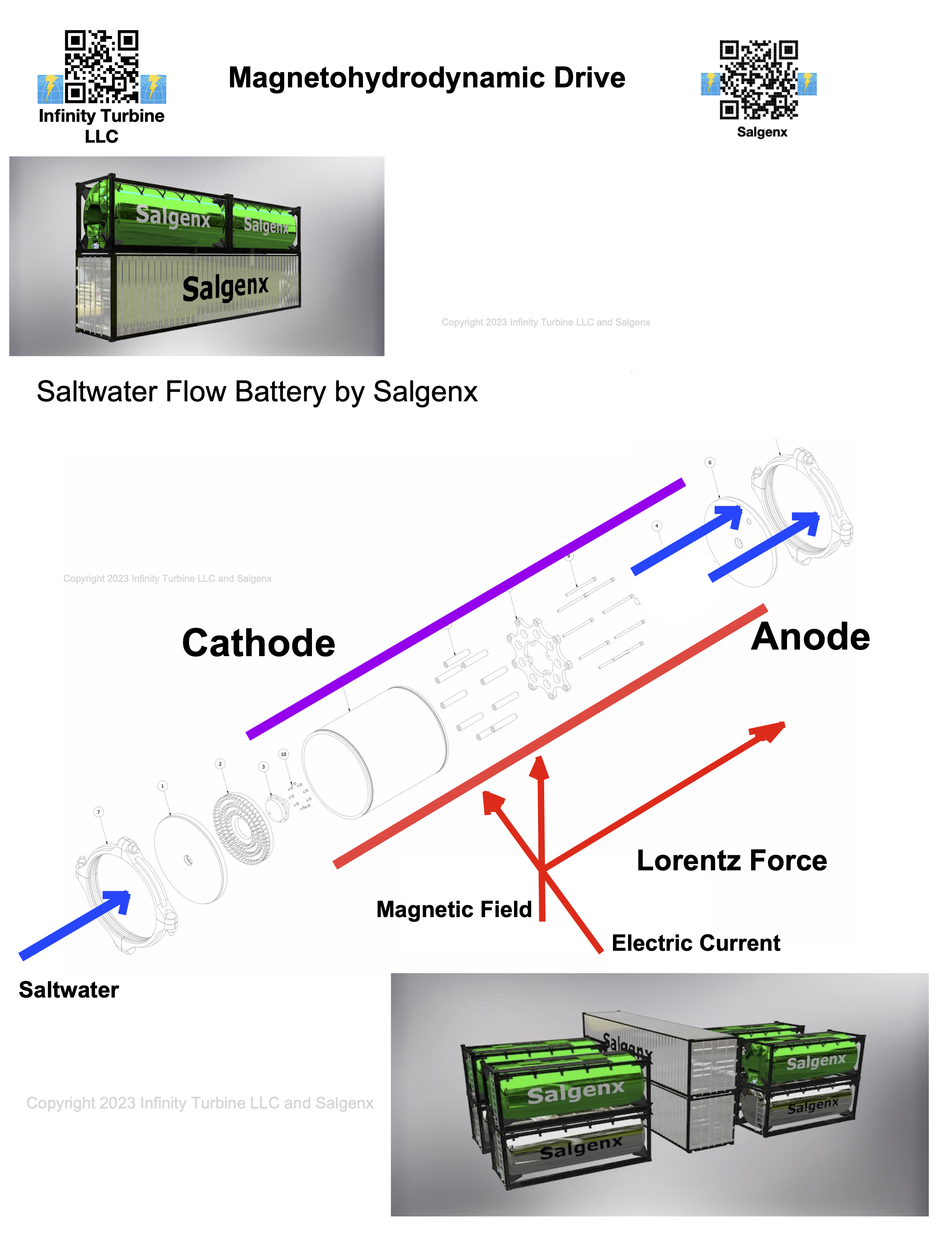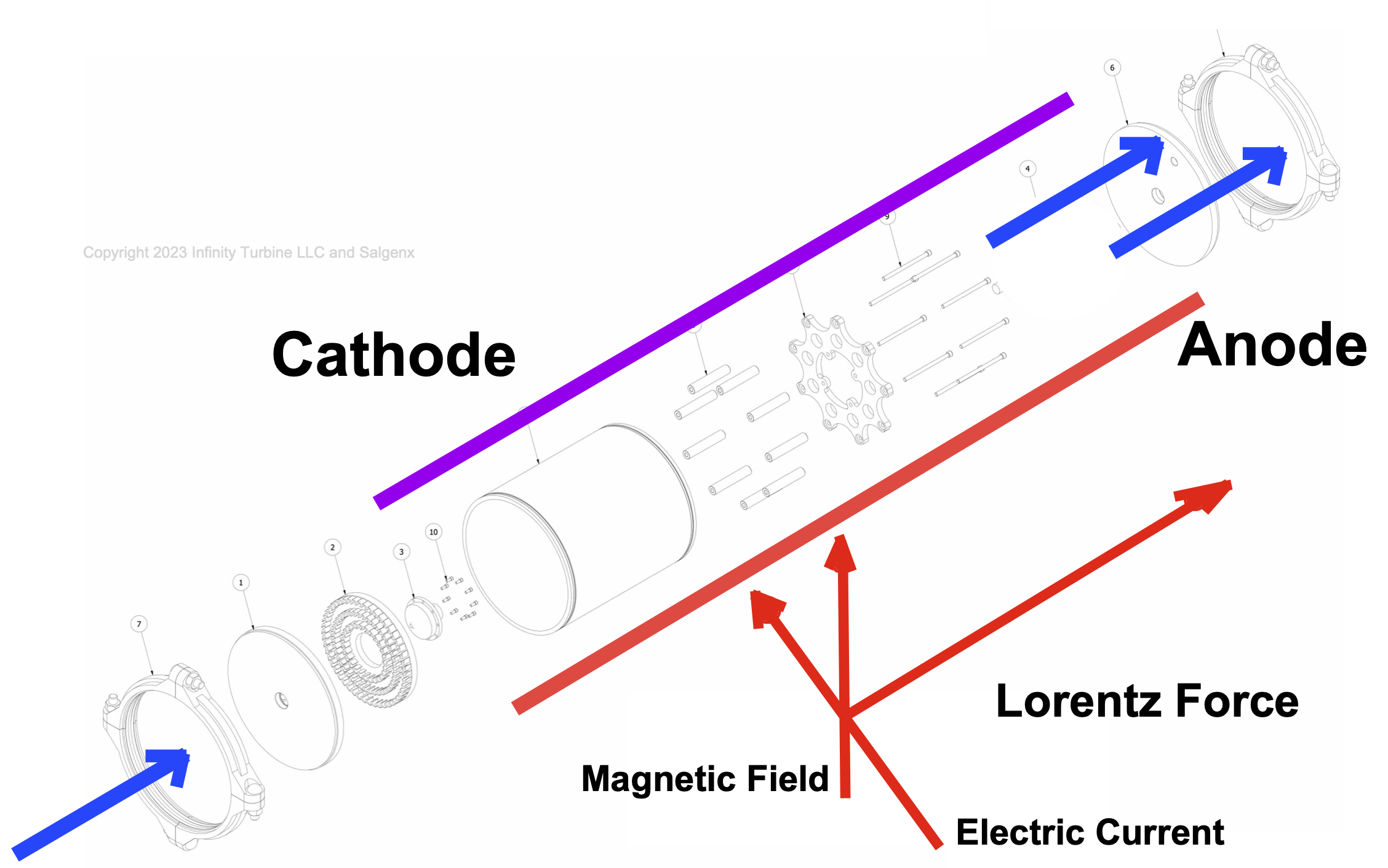
Salgenx magnetohydrodynamic mhd pump drive using in-situ Lorentz force to move saltwater

TEL: +1 608-238-6001 Email: greg@salgenx.com
Saltwater Redox Flow Battery Technology Report Salgenx has released its Saltwater Redox Flow Battery Technology Report, a pivotal resource that delves into the century-old technology recently validated by a $7 million US Military investment and experiments by the Pacific Northwest Laboratory. More Info
Our new cathode materials can do the following: • Self-healing electrode • Self-optimizing material • While charging, the system will automatically enhance itself and build conductivity. This system is revolutionary, and the only type of battery that can accomplish these tasks automatically while in use.
Manufacturing Licensing Now Available Price based on cathode material. Now discovering high surface area clays as potential cathode material lowering cost of deployment. Verified working as of 5 July 2024. More Info
Research and Development Notes Now Available Save years of research by purchasing our development... More Info

Salgenx magnetohydrodynamic mhd pump drive using in-situ Lorentz force to move saltwater |

|
Harnessing Magnetohydrodynamic Drive in Saltwater Flow Batteries for In-Situ Flow Enhancement IntroductionThe world's growing energy demands and the imperative shift towards cleaner, more sustainable technologies have spurred intensive research into innovative energy storage solutions. Among these, flow batteries have gained attention for their potential to offer scalable, long-duration energy storage. One intriguing development in this realm is the incorporation of magnetohydrodynamic (MHD) drives into saltwater flow batteries. This integration presents a fascinating approach to enhancing in-situ flow and improving the overall efficiency of these energy storage systems.Understanding the Basics: Flow Batteries and MHD DrivesFlow batteries are a type of electrochemical energy storage device that utilizes two electrolyte solutions, separated by a membrane, to store energy. The Salgenx Flow Battery does not require a membrane, but uses two immiscible electrolytes which naturally provide separation. By passing these electrolytes through electrochemical cells, they undergo redox reactions that store and release energy. This inherent design facilitates scalability, making flow batteries an ideal candidate for applications requiring high-capacity and long-duration energy storage.On the other hand, Magnetohydrodynamic (MHD) drives leverage the principles of electromagnetism and fluid dynamics to propel a conductive fluid, such as saltwater, through a duct or channel. When an electric current passes through the fluid, a Lorentz force is generated due to the interaction between the current and the magnetic field. This force propels the fluid, creating flow within the system.The Fusion: Integrating MHD Drives with Flow BatteriesThe concept of integrating MHD drives with saltwater flow batteries revolves around utilizing the Lorentz force generated by the MHD effect to induce and control the flow of the electrolyte solutions within the flow battery system. By placing appropriately positioned electrodes and magnets along the flow path, researchers can apply an electric current and a magnetic field, respectively, resulting in a driving force that enhances the flow of the electrolytes through the system.Benefits and Potential Applications1. Enhanced Flow Control: The integration of MHD drives provides a unique advantage in regulating and manipulating the flow rate of electrolytes within the battery. This capability allows for improved energy efficiency and better management of the electrochemical reactions, ultimately enhancing the overall performance of the flow battery.2. Energy Conversion Efficiency: The MHD-driven flow assists in maintaining uniform electrolyte distribution and minimizing concentration polarization at the electrode surfaces. This leads to enhanced energy conversion efficiency and improved cell performance.3. Longevity and Reliability: The controlled and consistent flow promoted by MHD drives helps mitigate issues like electrode fouling and sedimentation, contributing to the longevity and reliability of the flow battery system.4. Remote and Off-Grid Applications: The integration of MHD drives with saltwater flow batteries holds great promise for off-grid and remote applications, such as microgrids, renewable energy storage, and disaster response systems. These applications could benefit from the improved flow management and energy conversion efficiency.Challenges and Future DirectionsWhile the integration of MHD drives with saltwater flow batteries shows significant potential, several challenges need to be addressed before widespread implementation:1. Technical Complexity: Designing and implementing the MHD drive within the flow battery system requires intricate engineering and careful consideration of factors such as electrode positioning, magnet configurations, and flow channel geometry.2. Electrolyte Conductivity: The efficiency of the MHD effect depends on the conductivity of the electrolyte. Salgex needs to optimize the choice and composition of the electrolyte to maximize its conductivity while maintaining compatibility with the electrochemical reactions.3. System Integration: Integrating the MHD drive with existing flow battery technologies demands seamless coordination between fluid dynamics, electromagnetic fields, and electrochemistry.ConclusionThe integration of magnetohydrodynamic drives with saltwater flow batteries presents a promising approach to enhancing in-situ flow control and improving the energy efficiency of energy storage systems. By harnessing the principles of electromagnetism and fluid dynamics, researchers are exploring new avenues to address the challenges of energy storage and utilization. While technical challenges remain, the potential benefits for energy conversion efficiency, longevity, and remote applications make this hybrid concept an exciting area of research with a bright future. MHD Drive (pdf)
|
| CONTACT TEL: +1 608-238-6001 (Chicago Time Zone) Email: greg@salgenx.com | RSS | AMP | PDF | IG | A Division of Infinity Turbine |